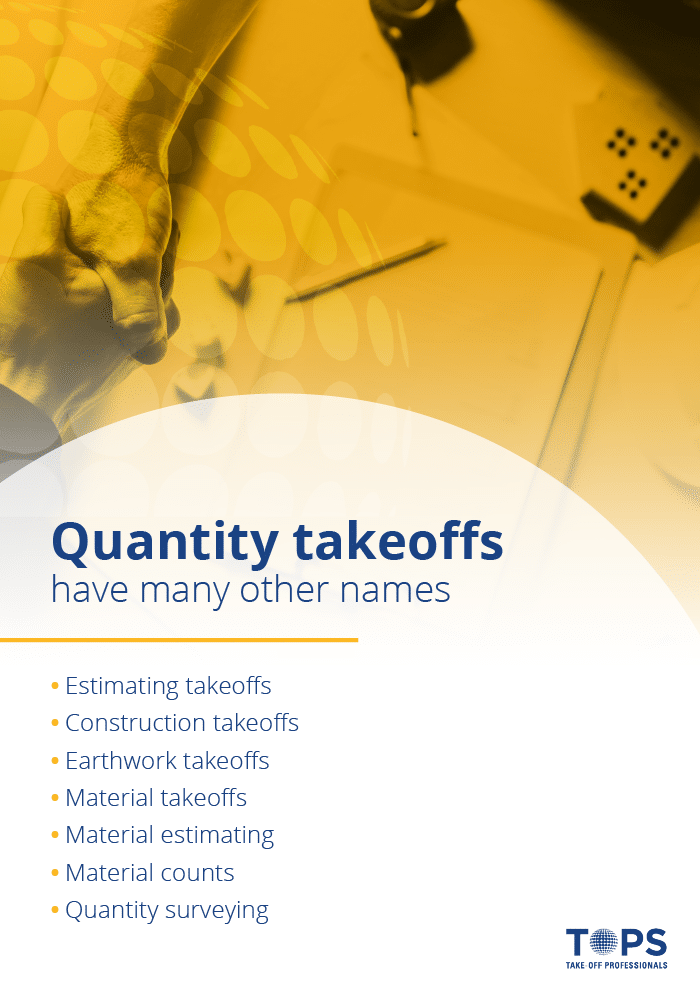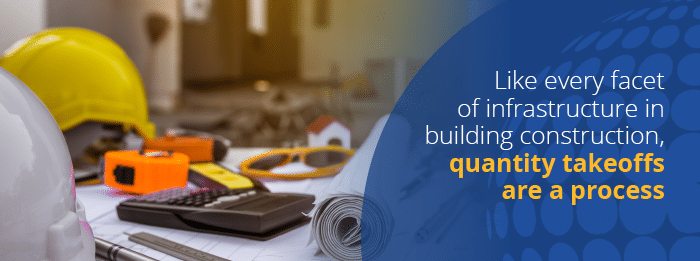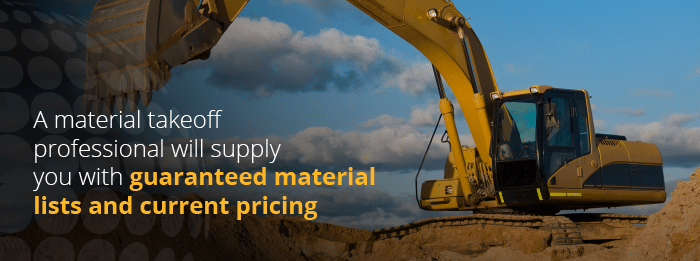As a professional involved in architecture, engineering and construction (AEC), you’re likely familiar with quantity takeoffs. The term has been around a long time in the building industry, and it reflects an important part of the planning process. Quantity takeoff requires a highly specialized skill set to do data management correctly.
This crucial step in a project’s early stage can make or break success. In fact, improper quantity takeoffs can underestimate or overestimate construction costs, causing inefficiency in the entire construction chain.
It can be detrimental to any job when required material amounts and realistic pricing values are overlooked or duplicated. The key to successful construction data collection is thoroughness and accuracy.
Defining Quantity Takeoff in the Building Industry
Explaining what a quantity takeoff is in construction is relatively straightforward. Quantity takeoffs (QTO) refers to the estimation of materials, resources, and labor needed to complete a construction project. You review the project plans and take off information about what physical materials the architect, engineer or draftsperson specifies to assemble the project.
Quantity takeoffs in construction have many other names, including:
- Estimating takeoffs
- Construction takeoffs
- Earthwork takeoffs
- Material takeoffs
- Material estimating
- Material counts
- Quantity surveying
Regardless of what you call them, quantity takeoffs are material-specific. As a rule of thumb, quantity surveyors or takeoff specialists don’t account for other project needs like labor, overheads, permits, insurance, equipment or incidentals. They stick to isolating material requirements and transposing that information into cost-based estimates.
Secure Winning Bids with Accurate Material Takeoffs
With TOPS, access professional material takeoffs boosting your project efficiency and bidding accuracy. Whether you have small-scale or vast earthworks planning needs, we ensure the best material takeoffs possible, enhancing productivity and profitability.
Innovations in Quantity Takeoff: Tech and Tools
Technology has changed the quantity takeoff method, and for larger construction companies, computerization has been invaluable. Today, advanced processes like Building Information Modeling (BIM) and Computer-Aided Design (CAD) significantly increase estimation accuracy. These tools help to solve the age-old problem of low productivity and excessive waste, as outlined in a commissioned report by the Economist Intelligence Unit. They simplify the construction takeoff process to save time and eliminate errors.
The Impact of Building Information Modeling (BIM) on Takeoffs
BIM is a set of 3D design and modeling software tools that help visualize construction designs from multiple angles. These software tools provide a virtual experience of a structure before physical construction to prevent conflicts between designs and site conditions. One of the most significant advantages BIM offers is increased collaboration, as it includes various tools that help teams interact throughout the construction process. BIM streamlines project design and communication for more accurate construction takeoffs.
The Role of Computer-Aided Design (CAD) in Quantity Takeoffs
CAD programs revolutionized the building industry by allowing companies to build their projects digitally before actually breaking ground. Structures are designed in a virtual environment as 2D drawings and 3D models, allowing teams to work out any bugs and then move forward with reduced-risk structures in the real environment.
CAD offers benefits such as:
- Optimized designs: Operators can test designs in various real-world conditions to identify the one that best meets project specifications and budget requirements. They can use these 2D and 3D models to optimize material usage.
- Improved quality: CAD allows for greater precision and attention to detail by providing comprehensive construction visualization. More accurate representations lead to more accurate quantity takeoffs that enhance the project’s overall quality.
- Decreased time: Using CAD facilitates efficient workflows that save time on project design and takeoff estimations. Operators can make adjustments quickly and collaborate with other team members seamlessly for quicker project completion.

Exploring Various Quantity Takeoff Methods
While computerization has increased takeoff accuracy and speed, the human element in quality takeoff examples can’t be replaced. Digital takeoffs are still at the mercy of human operators and interpreters just as manual takeoffs are. Today, we still rely on two quantity takeoff methods — manual and digital.
Traditional Manual Material Takeoffs
This is the oldest and simplest material takeoff form. Manual material takeoffs involve the estimator taking physical plans or blueprints and carefully detailing every material type and quantity specified on the construction drawings. This is a time-consuming data management process and prone to human error. It’s the estimator’s knowledge of materials, experience in estimating and skill in taking off material quantities that ensures accuracy. With manual methods, there’s no substitute for attention to detail.
Advancements in Digital Material Takeoffs
Performing material takeoffs through computer analysis and database application is relatively new in the construction industry. The first effective CAD-based programs date back to the late ’80s and ’90s, and their sophistication quickly evolved to include computerized building models integrated with digital takeoffs. Digital takeoffs are superior to manual methods for large and complex projects because of their speed and thoroughness. The qualifier is the takeoff technician being properly trained and proficient with the software application as well as highly attentive to applying the takeoff information into cost-based results.
Quantity takeoffs can be complex and involved processes. However, they have a single purpose, and that’s accurate data management. Whether you employ manual takeoff personnel or equip them with the latest digital takeoff program, the outcome must be an accurate list of all materials required to complete the project. It also has to conclude with a meaningful price structure.
Key Stakeholders in Quantity Takeoff Processes
Everyone involved in organizing the front end of a building project needs to do quantity takeoffs. Material takeoffs aren’t a tail-end qualifier. They’re a critical step that begins the bidding process to propose a realistic contract based on accurate material and financial information.
No matter how small or large your project scales, you have to start by calculating how much it will cost and how much material it will need. That’s whether you’re looking at a single residential unit or a larger subdivision undertaking with compounded earthworks, utilities, road surfaces and integrated above-ground structures. It begins by taking off materials, understanding what you have to work with and predicting the eventual price.
Architects, engineers and construction managers aren’t the only people needing to do quantity takeoffs. No matter what industry you’re in, if you build anything at all, you’ll require material calculation and price estimates. Here’s a list of professionals who need to do material takeoffs:
- Urban master planning and smart city designers
- Tunneling and subway architects
- Residential home builders and renovators
- Rail and metro transportation engineers
- Offshore and marine architects
- Landscapers and landscape architects
- Highway and road engineers
- General contractors and construction managers
- Energy and utility contractors
- Civil, mechanical and structural engineers
- Architects and all building designers
Conducting a quantity takeoff takes skill, patience and powers of observation. It also takes a lot of experience. Quantity surveying is a high skill and a vital component to support project proposals. In fact, material data estimation is such a critical part of construction that many managers retain specialized independent takeoff professionals to do quantity takeoffs for them.
Comprehensive Steps to Conduct a Quantity Takeoff
Like every facet of infrastructure in building construction, quantity takeoffs are a process. Learning how to do a material takeoff is a skill people can potentially manage if they have the time and resources to train in their system and then allow field time to polish their skills.

Learning in the field can be expensive. Humans are prone to error and manual takeoffs are especially open to misinterpretation, omission and wrongful calculation. So are digital takeoffs if the source input is wrong or the program operator fails to apply sound principles.
There are two ends to ensuring quantity takeoffs are sound and therefore meaningful. Deviating from either path can result in mistakes that can compound errors. An input error is sure to create a wrong end-calculation, and a bad output mistake can have equally damaging effects on money, time and inefficiency.
Getting a quantity takeoff correct is a matter of following a proven process. This formula has been around for years, and it’s the same method whether you use manual or digital takeoff methods. These are the two parts of doing an accurate quantity takeoff:
The Initial Phase: Input Considerations
Proper material takeoffs begin with inputting accurate information into the plans. Whether your draftsperson still hand-draws blueprints or your CAD operator creates multi-layered, three-dimension building models, your takeoff technician is paramount to managing data. This starts by inputting precise information onto the blueprints or into the computer-assisted takeoff software.
Your takeoff personnel only have so much control over what they’re given. Normally, a designated estimator won’t prepare the original concepts, working drawings or CAD layouts. Others in the building chain usually design and specify projects. However, an astute takeoff tech can spot irregularities and account for them during their data management. This is a critical control in the input stage.
The Final Phase: Output Specifications
Performing material takeoffs is core to the data management output stage. Output turns concepts into physical entities, and this is where accurate material estimation is essential. Putting out hard figures from software printouts creates solid estimates, which are the foundation for successful bids.
Here is where your takeoff person or team has control. Setting aside errors and omissions, your material takeoff relies on a system of identifying materials, quantifying them and then attaching data to a price schedule. This systematic approach, if done right, results in a fair an accurate proposal to move the project forward.
Construction data management professionals take material takeoff output and put this information into schedules based on valid pricing structures. In small-scale projects, estimators might use values based on local suppliers or subcontractors. In large building proposals, estimators often use national pricing. Takeoff professionals know where to look for quality data to use in a quantity takeoff.
Criteria for Evaluating a Quantity Takeoff
For the most part, doing a quantity takeoff is a mathematical exercise. You extract or extrapolate material figures on the input side for the takeoff quantities in civil engineering. On the output end, you reference your material figures to values. This creates a base for a total project estimate which adds in additional costs for labor, equipment and overhead.
You’ll hear the term “quantity” used in material takeoff discussions. This is the name for identifying quantities of earthwork material being estimated. It might be the quantity of cut and fill required for earthworks. Or, it might be the quantity of pipe, steel or lumber necessary to complete a structure.
Quantity surveyors or material takeoff professionals have a special challenge. They have to turn two-dimensional plans into three-dimensional images to quantify them. Accurate quantity takeoffs come from both the two-dimensional and three-dimensional worlds.
With manual takeoff methods, the surveyor needs to think two and three-dimensionally and visualize the concept. Digital takeoff methods relieve a lot of this spatial load, but a technician still has to manage that data. Here are the base formulas takeoff professionals use to look for and quantify construction materials:
- Unit count: This is the simplest takeoff task, yet it’s easy to miss something in a unit count. When planning a building, estimators will count single items such as light fixtures, pipe fittings or door knobs. They calculate the total unit figures and multiply by unit price to achieve a gross total.
- Linear length: Total lengths or runs are specific to materials like lumber, steel and piping. These building products are difficult, or nearly impossible, to unitize. Estimators will add up the combined linear lengths of materials in this category and also add a gross value to it.
- Surface area: Accurately estimating surface area materials is still a two-dimensional task. It doesn’t matter if it’s flatwork stones, floor coverings or roofing materials. The calculation is length times width, and this total gets quantified to a value.
- Cubic volume: Here’s where the three-dimensional reality enters the material takeoff business. Earthworks, concrete pours and insulation are prime examples where you’d use a cubic volume takeoff. This is length times width times height, and it’s applied as a unitized number on a value column.
- Physical weight: Calculating construction by weight often happens in addition to other takeoff quantification. You might hear pounds of steel or tons of backfill. Calculating physical weight is necessary when accounting for transportation costs.
Although material takeoff professionals pay strict attention to their two and three-dimensional calculations, they realize their figures eventually support two more construction dimensions. Time is an additional dimension on construction projects, as is cost. Because of time and cost, it’s vital to make sure material takeoffs are done right.
The Advantages of Precise Quantity Takeoffs
Quantity takeoffs have a significant effect on multiple project aspects, from initial design stages to project execution and construction. Ensuring precision in quantity takeoffs will set a project up for the greatest success. Accurate quantity takeoffs provide a detailed breakdown of needed materials, and by quantifying these needs, estimators can calculate costs that enhance project components such as:
- Project estimation: Quantity takeoffs are the foundation of project estimations, so the more accurate the quantity takeoff is, the more accurate the project estimation will be. These estimates can determine whether a project is feasible within budget constraints and if it can be completed according to client needs and expectations.
- Bidding: Accurate quantity takeoffs enable construction companies to place more competitive bids. With precise calculations for material quantities, companies can avoid overestimating or underestimating and demonstrate their efficiency and professionalism to win successful bids.
- Budgeting: Budgeting precision is a result of accurate quantity takeoffs. Careful counting and calculations for material needs allow construction companies to estimate accurate expenses and deliver projects within budget.
As precise quantity takeoffs improve the accuracy of project estimations, bidding and budgeting, construction companies can:
- Minimize material waste: Accurate quantity takeoffs determine the exact amount of materials needed for a project, helping to reduce overestimations. With accurate material needs, companies can optimize orders to reduce waste and increase profits.
- Improve time management: Beginning a project with accurate quantity takeoffs can save time by reducing project delays arising from inadequate or incorrect material supplies. Precise quantity takeoffs also streamline project planning to speed up design stages and project execution.
- Prevent costly rework: When quantity takeoffs are based on precise calculations, companies can ensure accuracy throughout the project’s duration to prevent expensive errors. Estimators can provide accurate, detailed information that prevents rework and promotes project success from the beginning.
- Enhance collaboration: Clarifying material needs through accurate quantity takeoffs enables various teams to coordinate and communicate effectively throughout project design and construction. Clear project estimations promote transparent communication with clients, increasing their satisfaction and loyalty.
- Perform cost tracking: Accurate quantity takeoffs enable effective cost tracking by yielding a clear picture of necessary, realistic expenses. They support informed decision-making by helping team members anticipate costs, reduce budget overruns and accommodate unexpected expenses.
- Manage documentation: An accurate quantity takeoff serves as a valuable baseline for documentation and record-keeping. It provides a record of estimated quantities and costs that can be referenced throughout the project to assist with change management, progress evaluation and post-project analysis.
The Importance of Accuracy in Quantity Takeoffs
The United States construction industry generates huge costs and consumes massive time. American construction projects generate billions of dollars and employ millions of workers. Because of the money and people affected, it’s important to get material takeoffs right.
You have two main material takeoff options. The first is using the old and antiquated manual method. The other is using a modern and more accurate digital takeoff system. Your choice might depend upon how much time you have and what the cost of a digital takeoff system will run you.

Comparing time and cost against accuracy might be a tough data management decision. Fortunately, you have a third choice. This one makes a lot of sense when you’re under a time constraint and demand estimation accuracy.
It’s turning to a material takeoff professional to estimate for you. These experienced construction experts make sure your takeoffs are accurate, thorough and dependable. You can trust them to support your bids and your business.
Partner with Take-Off Professionals for Expert Assistance
We’re Take-Off Professionals (TOPS). We’re a team of experienced and knowledgeable engineers who will produce accurate data so you can manage your business and build your projects without construction estimation worry.
TOPS offers takeoff services to meet your individual needs. You might be a small-volume builder needing a simple material list to complement your proposal. Or, you might require a comprehensive plan for cutting, hauling and filling earthworks. Whatever your need, TOPs can help improve your productivity by ensuring you have the sharpest information based on the best material takeoffs possible.
Professional material takeoffs increase your bidding accuracy and work efficiency. This results in saved money and greater profits. For more information on how we can help with our quantity takeoff services, call the Take-Off Professionals today at 623-323-8441 or connect with us online.


